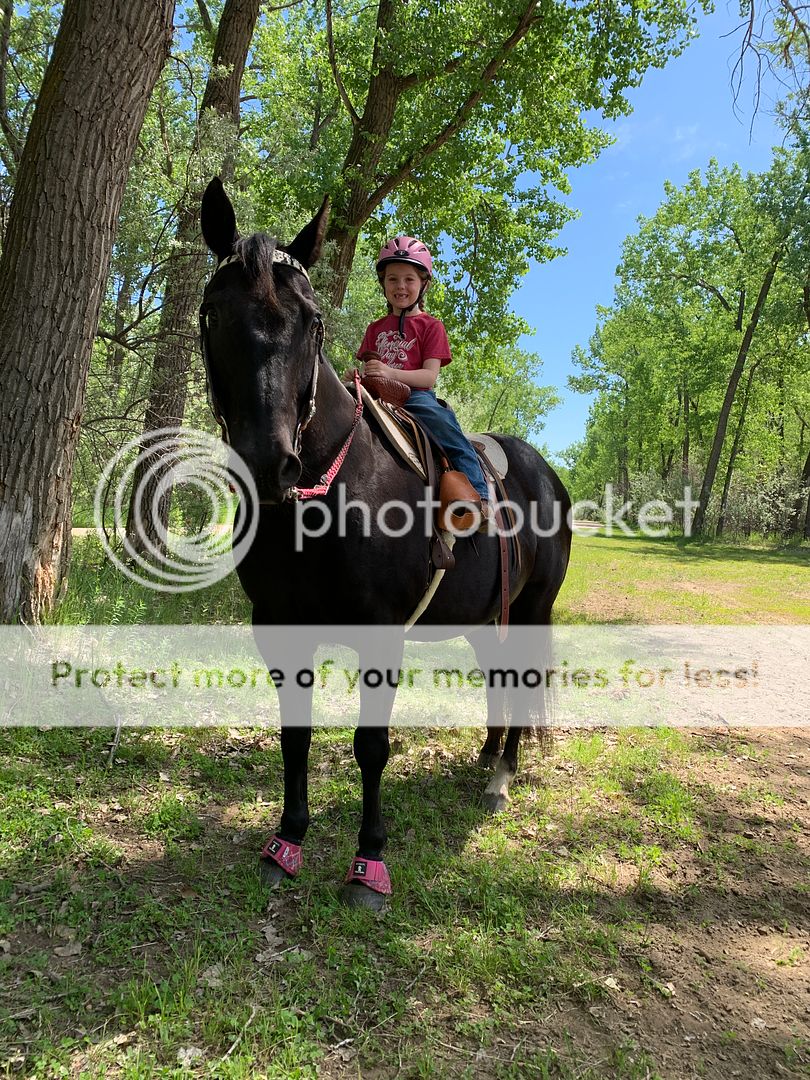Oh, I feel like I don’t know what else to try for my daughter’s horse and lightly considering getting him a neurectomy later this year. I thought I’d reach out to the brilliant minds of COTH to see if I am missing anything else I can try for his navicular or if there are any success stories after a neurectomy.
Horse is an angel for my daughter. She will be 7 years old this summer. She’s a very timid child and he is just perfect for her. He listens so well and is a do-gooder. So my entire goal is to keep him sound enough for her. She’s currently just walking and trotting on him, maybe once or twice a week. I don’t know if she’ll be brave enough to start loping on him this year or not. Either way, it’s very light work.
Of course, I have to include a picture of the sweet boy.
He will be 17 years old this year. AQHA. We bought him when he was 10 years old. He had a hard life before that (cowboys … and not good ones). He’s had some mild bony changes in his front feet since we bought him but he surprisingly was never that bothered by it clinically; just mild. His hocks were fusing when we bought him and that bothered him more, but was easily managed with hock injections. He did almost die (not joking) when he was 13 years old when he got a hock joint infection from impaling his hock on something, but he shockingly made a full recovery and I was even able to make a couple barrel runs on him again after almost 2 years.
But… it’s those darn front feet. I’m not sure if the hock injury expedited problems on his front feet (just due to keeping weight off his hind leg) or maybe it had nothing to do with it.
This year, I’ve really noticed he has that “navicular stance” where he is camped out. I hop on him once in a while, maybe once every couple weeks, just to really keep him soft for my daughter and I can just feel that he is ouchy on those front feet.
In 2021, I tried Osphos injection. Didn’t help at all.
Also in 2021, I tried having him on pentosan most of the year. Didn’t help at all.
Last year (2022), I tried regular steroid injections into the coffin joint. Didn’t help at all.
I pretty much keep him on daily Equioxx during the summer months but I just feel like it wasn’t doing much at all in 2022 as he was still symptomatic.
Once upon a time (before the hock infection incident) I did have shoes/pads on his front feet but I really am not sure how much it actually helped at that time. So he’s been barefoot since the incident anyway.
I always put his SoftRide boots on his front feet anytime that he is going to be standing tied to the trailer for a length of time, and anytime I haul.
Part of me is leaning toward just doing the neurectomy in order to make him more comfortable. But I also know those don’t last forever (and could last as short as 6 months) and it only covers up the pain. I’m just trying to figure out how I can make him last for her!!!
My goal for this spring, when our mountains of snow melt, is to treat him with my PEMF system every day for two week while also back on the Equioxx, and see if that makes a dent in how his front feet feel. Since he is my daughter’s horse, I admit he takes a back seat to my 2 main horses and I made time for them to get the PEMF treatments but I just would always run out of time for him. And I just need to figure out to get him the time too. (Who needs sleep anyway…)
I’m not opposed to putting shoes/pads on him, as my other main horse has special shoeing needs, but I might give the PEMF a chance first. Part of me has a hard time putting shoes on a horse in very light work, but I also am thinking long-term and what is long-term going to be best for him.
I have to haul about 6 hours to get to someone who can do the neurectomy, which isn’t a problem for me. My one concern with the nerving is that if the navicular gets worse, he won’t feel it, and won’t show me that he’s getting worse. Has anyone had that happen?
My horses are turned out 24/7 on pasture year round. So he’s never locked up and always can move around as he pleases. Which I hope is helpful to him.


 Again, I’m really only lightly considering it and of course would do what my vets direct me to do prior to the procedure.
Again, I’m really only lightly considering it and of course would do what my vets direct me to do prior to the procedure.